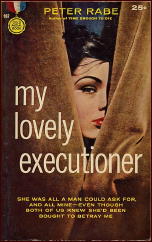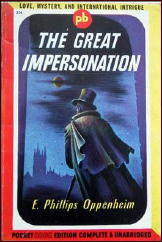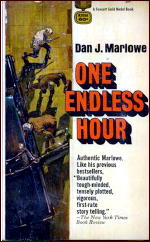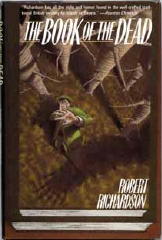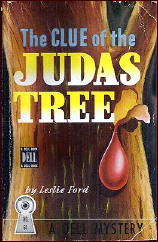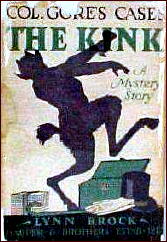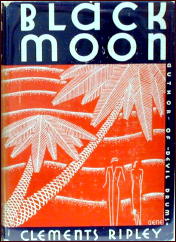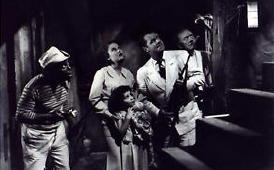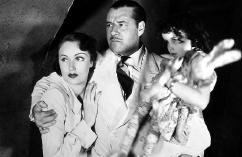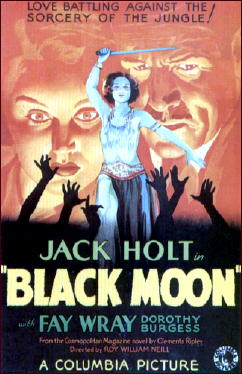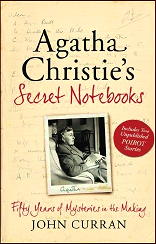Mon 11 Nov 2013
by Michael Shonk
Remakes of TV series are so popular it seems everyone is doing it. Books continue the stories of MURDER SHE WROTE and MONK, comic books keep BUFFY THE VAMPIRE and THE MIDDLEMAN alive, and movies (and the studios that make them) love dead TV series. One could make a long list of TV series that have made it to the big screen including GUNN (1967, based on PETER GUNN), A TEAM, POLICE SQUAD, X-FILES, STARSKY AND HUTCH, etc. So it is no surprise television occasionally turns to its own past.
Not all remakes are a bad thing. Look at the past of COLUMBO. The character Columbo first appeared in an episode of the TV anthology series THE CHEVY MYSTERY SHOW in “Enough Rope†(NBC 7/31/60). The story for the episode was partly based on a short story “May I Come In†(published in ALFRED HITCHCOCK MYSTERY magazine under the title “Dear Corpus Delictiâ€) that did not have Columbo in it.
In 1962 the TV episode was remade into a stage play “Prescription Murder†which was adapted into a NBC TV Movie in 1968 starring Peter Falk. In 1971 the character returned in a NBC TV Movie called “Ransom For a Dead Man.†COLUMBO then became one of the rotating series in NBC MYSTERY MOVIE from 1971 until 1978. ABC brought back the cancelled series in 1989 for a series of TV Movies, first as part of ABC MYSTERY MOVIE (1989-1990) series, then as randomly scheduled TV Movies that lasted until 2003.
The resurrection of cancelled TV series is so common there is a book out covering the subject, TV FAST FORWARD: SEQUELS & REMAKES OF CANCELLED TV SERIES 1955-1992 (McFarland & Co. 1993) by Lee Goldberg (DIAGNOSIS MURDER). No doubt the book would double in size if it were brought up to date. To avoid a book long post here, I decided to be extra picky about what I include (feel free to ignore my rules in the comments). What I discovered was how much of TV’s best shows were adapted from other mediums.
So it must be original for TV. No series based on characters from books. Bye Sherlock Holmes, The Saint, Nero Wolfe, Ellery Queen, Mike Hammer, Perry Mason, Dracula, THE UNTOUCHABLES, HOUSE OF CARDS, and even STREETS OF SAN FRANCISCO (yes, the two main characters were based on books by Carolyn Weston). No films. Bye LA FEMME NIKITA, ROBOCOP, and MCCLOUD. No plays. Bye CASABLANCA. No radio. Bye DRAGNET and GUNSMOKE. No comics. Bye BATMAN, SUPERMAN, FLASH GORDON, HUMAN TARGET and THE TICK. Not even “pulpsâ€. Bye SHEENA QUEEN OF THE JUNGLE.
The remake must have aired on American TV. No unaired pilots.
I will limit myself to the mystery/crime genre. But every genre has many TV remakes of its own including science fiction with STAR TREK, and BATTLESTAR GALACTICA, westerns with MAVERICK, KUNG FU, and BONANZA, action with SEA HUNT and DUKES OF HAZZARD, romance with CUPID and LOVE BOAT, horror with DARK SHADOWS, KOLCHAK THE NIGHT STALKER and THE ADDAMS FAMILY, children’s programs with SCOOBY DOO and BUGS BUNNY, comedies with GILLIGAN’S ISLAND, GIDGET, and ANDY GRIFFITH SHOW, and dramas with DALLAS and THE FUGITIVE.
Cancelled series getting remade as pilots is nothing new but perhaps the earliest to make it back on the air was TIGHTROPE (CBS 1959-60) with unsold pilot THE EXPENDABLES that aired on ABC 9/27/62.
Starting in the 1970s the TV Movie became a popular format. The increase demand for content had each network looking everywhere for program ideas including its dead but not totally forgotten TV series.
TV series to return as TV Movies included RETURN OF THE MOD SQUAD (ABC 1979), RETURN OF FRANK CANNON (CBS 1980), RETURN OF THE MAN FROM U.N.C.L.E. (CBS 1983), STILL CRAZY LIKE A FOX (CBS 1987), WILD WILD WEST REVISITED (CBS 1979), MORE WILD WILD WEST (CBS 1989), and I SPY RETURNS (NBC 1994).
PETER GUNN returned to TV in a TV Movie (ABC, 1989) starring Peter Strauss. According to TV FAST FORWARD, the PETER GUNN TV Movie was a pilot that, along with MURPHY’S LAW (starring George Segal), would have been part of ABC MYSTERY MOVIE. But ABC went with Universal studios for COLUMBO and KOJAK remakes instead. MURPHY’S LAW (based on a book series TRACE that was a remake of a book series DIGGER, both written by Warren Murphy) was picked up as a weekly series but PETER GUNN was not.
Others to rise from the dead in TV Movies included James Garner in THE ROCKFORD FILES (CBS 1994-99), Angela Lansbury in MURDER, SHE WROTE (CBS 1997, 2000 -2003). Robert Wagner and Stefanie Powers in HART TO HART (NBC 1993-94; Family Channel 1996-97).
POLICE STORY started as a weekly series on NBC (1973-77). In 1977 the series changed from 60-minute episodes to TV Movies that ended in 1978. In 1987-88 NBC brought POLICE STORY back for a series of TV Movies.
During the late 1980’s the market for programs exploded with the addition of new networks Fox, UPN, WB, and cable networks such as USA. The number of TV series remakes (the return of at least one of the original cast) and reboots (old series with new cast) increased.
Perhaps the strangest series remake was for ALFRED HITCHCOCK PRESENTS. During the series first run (1958-65) it bounced between CBS and NBC with different titles, the one thing uniting the series was host Alfred Hitchcock. Producer Christopher Crowe wanted to do an anthology series but had recently failed with one, DARKROOM (ABC 1981-82). The networks were not interested until he mentioned ALFRED HITCHCOCK PRESENTS.
NBC aired the NEW ALFRED HITCHCOCK PRESENTS first as a TV Movie in 1985. Based on the TV Movie’s success NBC made it a weekly series that aired from 1985 to 1986, then NBC moved it to its sister station cable network USA. The series featured Alfred Hitchcock as host which was unusual as Hitchcock had died in 1980 five years earlier. The series colorized Hitchcock’s original black and white introductions and used them with the new stories.
Cancelled TV series that have made the comeback to weekly series include BURKE’S LAW (ABC 1963-66; CBS 1994 -95). An episode from the remake is currently available on YouTube.
Others to return from cancellation as a new weekly series included THE FBI (ABC 1965-74) that was rebooted as TODAY’S FBI (ABC 1981-82), THE HITCHHIKER (HBO 1983-87) waited until 1989 when it aired on USA until 1991. And HAWAII FIVE-O (CBS 1968-80) has returned as HAWAII FIVE-0 (CBS 2010-present).
CHARLIE’S ANGELS (ABC, 1976-81) enjoyed a successful theatrical series run after ABC cancelled the series before crashing in a terrible TV series remake (ABC 2011). MISSION: IMPOSSIBLE (CBS 1966-73) got its TV remake series (ABC 1988-90) first before being rebooted into a successful movie series. There are episodes from the remake currently on YouTube.
https://www.youtube.com/watch?v=ISDAXbzuRa8
IRONSIDE (NBC 1967-75) returned in 1993 with the original cast in TV Movie RETURN OF IRONSIDE. NBC rebooted the series in 2013 with Blair Underwood as Ironside. This was not the first rebooted TV series that changed the race of a main character.
THE NEW ADAM 12 (syndicated, 1990) still featured a police car patrolling the city, but the black and white now had two different cops inside, one white and the other black.
KOJAK (CBS 73-78; CBS TVM 1985 and 1987; ABC (part of ABC MYSTERY MOVIES) 1989-90; USA 2005 – weekly series) Kojak, TV’s most famous Greek-American detective played by Telly Savalas (who died in 1994), would be recast with black actor Ving Rhames taking over the role of Kojak for the 2005 USA network series.
As with IRONSIDE and KOJAK, there have been cancelled series that have enjoyed the afterlife as a TV movie and TV series.
GET SMART (NBC 1965-69; CBS 1969-70) has been remade and rebooted in a variety of forms including a TV movie GET SMART AGAIN (ABC 1989) and a TV series sequel (FOX 1995).
KNIGHT RIDER (NBC 1982-86) first returned on NBC in TV Movie KNIGHT RIDER 2000 (1991). Syndicated TV movie KNIGHT RIDER 2010 (1994) kept little but the title. Next was syndicated TV series TEAM KNIGHT RIDER (1997-98). NBC tried one more time and rebooted the original version with a TV Movie and TV series in 2008-09.
While SIX MILLION DOLLAR MAN was based on a book, the Bionic Woman Jaime Sommers (Lindsay Wagner) was a character created for the TV series in 1975 and spun off to her own TV series, BIONIC WOMAN (ABC, 1976-77; NBC 1977-78). She also appeared in the three TV Movie remakes of the SIX MILLION DOLLAR MAN on NBC (1987-94). NBC rebooted the series again for a series in 2007 that had Michelle Ryan taking over the role of Jaime Sommers.
HUNTER (NBC 1984-91) returned on NBC as TV Movies in 1995, 2002 and in 2003. In 2003 a weekly series was attempted but lasted only three hour-long episodes. YouTube currently has the 2003 episodes on line. Here is episode three.
https://www.youtube.com/watch?v=e2jT6CrM63Y
The British and American have been exchanging TV series since the 1960s. Today PBS and BBC America make sure American’s see the British originals and British remakes of US series such as LAW AND ORDER UK (2009-present), while other networks are shopping all over the world for shows to Americanize.
THE AVENGERS (United Kingdom 1961-69) aired on ABC (1966-69). The remake THE NEW AVENGERS aired in the UK from 1976-77 and aired on CBS in 1978-79. CBS wanted to do an American version. It was to be produced by Quinn Martin and created by Brian Clemens (THE AVENGERS). It was called ESCAPADE (that may have aired once on CBS in 1978). Here is a YouTube clip of the opening.
British series that had American versions included CRACKER (1993-95) remade by ABC (1997-1999), BLACKPOOL (2004) became VIVA LAUGHLIN (CBS 2007), LIFE ON MARS (2006-07) with ABC’s version airing 2008-09, and ELEVENTH HOUR (2006) remade by CBS (2008). THE PRISONER (1967-68) was shown on CBS in 1968 and rebooted by AMC in 2009. LOW WINTER SUN (AMC 2013) was based on the British LOW WINTER SUN (2006).
Remakes not only come from our past and the United Kingdom, but now from all over the world.
Israel has inspired two American series. HOMELAND (SHOWTIME 2011-present) is based on PRISONER OF WAR (aka HATUFIM) (2009- present). HOSTAGES (CBS 2013-present) is airing at almost the same time as Israeli version of HOSTAGES (BNEI ARABA).
Other countries supplying programs for American remakes are Denmark with FORBRYDELSEN (2007-12) rebooted as THE KILLING by AMC (2011-2013). THE BRIDGE (F/X 2013-present) is based on a Denmark-Sweden coproduction (Danish: BROEN; Swedish: BRON – 2011-present). While Netherlands PENOZA (2010-12) inspired RED WIDOW (ABC 2012). And coming soon to FOX is RAKE, based on the Australian series (2010-present).
With the increasing number of places and ways the audience can find programs, places such as Amazon, Hulu, Netflix, and YouTube where you don’t even need a TV set to watch, new programs need to find some way to stand out in the crowd. The remake is a quick easy way to attract attention, but just the title will not make any series successful. The series still has to be good enough to make viewers want to watch it next week.
SOURCES:
TV FAST FORWARD by Lee Goldberg
IMDb
TV Tango
Wikipedia
